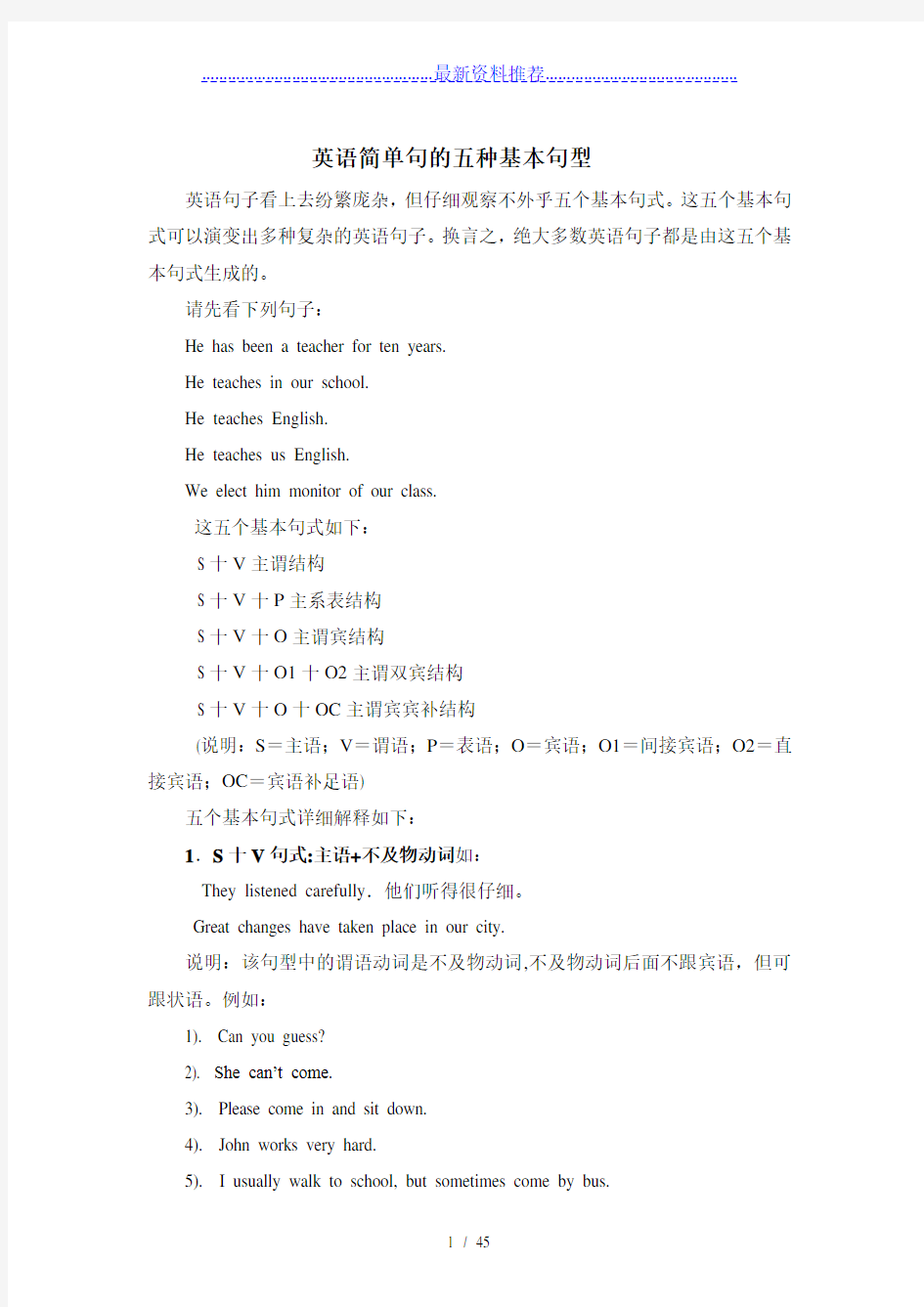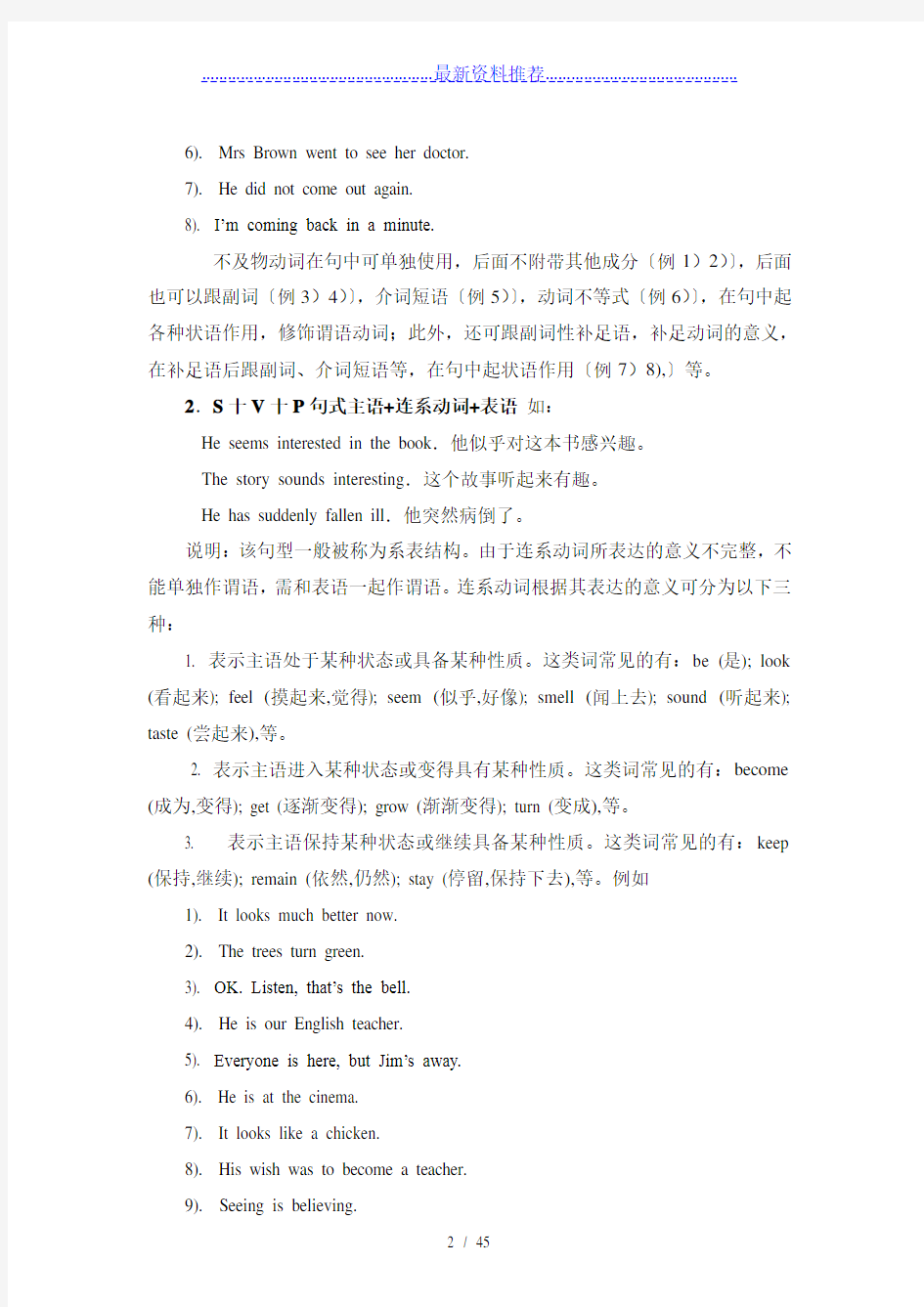

英语简单句的五种基本句型
英语句子看上去纷繁庞杂,但仔细观察不外乎五个基本句式。这五个基本句式可以演变出多种复杂的英语句子。换言之,绝大多数英语句子都是由这五个基本句式生成的。
请先看下列句子:
He has been a teacher for ten years.
He teaches in our school.
He teaches English.
He teaches us English.
We elect him monitor of our class.
这五个基本句式如下:
S十V主谓结构
S十V十P主系表结构
S十V十O主谓宾结构
S十V十O1十O2主谓双宾结构
S十V十O十OC主谓宾宾补结构
(说明:S=主语;V=谓语;P=表语;O=宾语;O1=间接宾语;O2=直接宾语;OC=宾语补足语)
五个基本句式详细解释如下:
1.S十V句式:主语+不及物动词如:
They listened carefully.他们听得很仔细。
Great changes have taken place in our city.
说明:该句型中的谓语动词是不及物动词,不及物动词后面不跟宾语,但可跟状语。例如:
1). Can you guess?
2). She can’t come.
3). Please come in and sit down.
4). John works very hard.
5). I usually walk to school, but sometimes come by bus.
6). Mrs Brown went to see her doctor.
7). He did not come out again.
8). I’m coming back in a minute.
不及物动词在句中可单独使用,后面不附带其他成分〔例1)2)〕,后面也可以跟副词〔例3)4)〕,介词短语〔例5)〕,动词不等式〔例6)〕,在句中起各种状语作用,修饰谓语动词;此外,还可跟副词性补足语,补足动词的意义,在补足语后跟副词、介词短语等,在句中起状语作用〔例7)8),〕等。
2.S十V十P句式主语+连系动词+表语如:
He seems interested in the book.他似乎对这本书感兴趣。
The story sounds interesting.这个故事听起来有趣。
He has suddenly fallen ill.他突然病倒了。
说明:该句型一般被称为系表结构。由于连系动词所表达的意义不完整,不能单独作谓语,需和表语一起作谓语。连系动词根据其表达的意义可分为以下三种:
1. 表示主语处于某种状态或具备某种性质。这类词常见的有:be (是); look (看起来); feel (摸起来,觉得); seem (似乎,好像); smell (闻上去); sound (听起来); taste (尝起来),等。
2. 表示主语进入某种状态或变得具有某种性质。这类词常见的有:become (成为,变得); get (逐渐变得); grow (渐渐变得); turn (变成),等。
3. 表示主语保持某种状态或继续具备某种性质。这类词常见的有:keep (保持,继续); remain (依然,仍然); stay (停留,保持下去),等。例如
1). It looks much better now.
2). The trees turn green.
3). OK. Listen, that’s the bell.
4). He is our English teacher.
5). Everyone is here, but Jim’s away.
6). He is at the cinema.
7). It looks like a chicken.
8). His wish was to become a teacher.
9). Seeing is believing.
10). That book is very interesting.
11). Wei Hua’s pen was broken
12). That’s why I was late for class.
表语用来表示主语的身份、状态或性质。能在句中作表语的有形容词〔例1)2)〕,名词〔例3)4)〕,副词〔例5)〕,介词短语〔例6)7)〕,不定式短语〔例8)〕,动词-ing形式〔例9)10)〕,过去分词〔例11)〕,从句〔例12)〕,等。
3.S十V十O句式: 主语+及物动词+宾语如:
I saw a film yesterday.我昨天看了一部电影。
Have you read the story? 你读过这个故事吗?
说明:该句型中的谓语动词是单宾及物动词,动词方面要求跟一个宾语。例如
1). May I ask some questions?
2). We are going to play football.
3). I can see them. But I can’t reach them
4). Children often love to play this game.
5). Because my father wanted to work inChina.
6). We really enjoyed working on the farm.
7). It doesn’t matter. I like walking.
8). I hope you all have a good time.
9). I know who picked the fewest.
宾也是谓语动词动作行为的对象,说明主语做什么。能在句中作宾语的有名词〔例1)2)〕,代词〔例3)〕,动词不定式〔例4)5)〕,动词–ing形式〔例6)7)〕,从句〔例8)9)〕等。
4.S十V十O1十O2句式主语+及物动词+间接宾语+直接宾语如:
He gave me a book/a book to me.他给我一本书。
He brought me a pen/a pen to me.他带给我一枝钢笔。
说明:该句型中的的谓语动词是双宾及物动词.这类动词后面需要跟一个间接宾语和一个直接宾语意思才完整。表示动作是对谁或对什么发出的。例如:
1). The teacher gives one of them an eraser.
2). Could you pass me the salt, please.
3). Go and bring me some food.
4). I’m rich, so I can’t buy myself lots of good things.
在双宾结构中,间接宾语通常指人,直接宾语通常指物,正常语序通常是间接宾语在前,直接宾语在后。但当直接宾语时代词是,或直接宾语比间接宾语短得多时,或需要强调间接宾语时,通常间接宾语置于直接宾语之后。这是间接宾语前需要用一个介词to或for。例如:
1). I wanted to show it to you.
2). You mustn’t lend it to others.
3). Please buys a bottle of ink for me.
4). Can you draw a picture of a sheep for me?
用to还是for取决于前面的动词。
A:bring, give, hand, leave, lend, pass, pay, return, send, teach, tell, throw, write,等动词后跟to。
B:buy, cook, do, find, get, make, play, sing, save,等动词后跟for。
5.S十V十O十C句式主语+及物动词+宾语+宾语补足语如:
They made the girl angry.他们使这个女孩生气了。
They found her happy that day.他们发现那天她很高兴。
They named the boy Charlie.他们给这个男孩起名为查理。
I saw him come in and go out.我见他进来又出去。
They felt the car moving fast.他们感到汽车行驶得很快。
说明:该句型中的谓语动词是复宾及物动词。这类动词的特点是不仅需要跟一个宾语,而且还需要跟一个宾语补足语意思才完整。宾语和宾语补足语一起构成复合宾语。宾语和宾语补足语在逻辑上有一种主谓关系。即宾语补足语表示宾语是什么,或表示宾语所处的状态,或表示宾语发出的一个动作。例如:
1). We made him our monitor.
2). But why do you call them mooncakes?
3). We must keep it cool.
4). Don’t get your hands dirty.
5). Don’t let the children in.
6). He told me not to bring you anything.